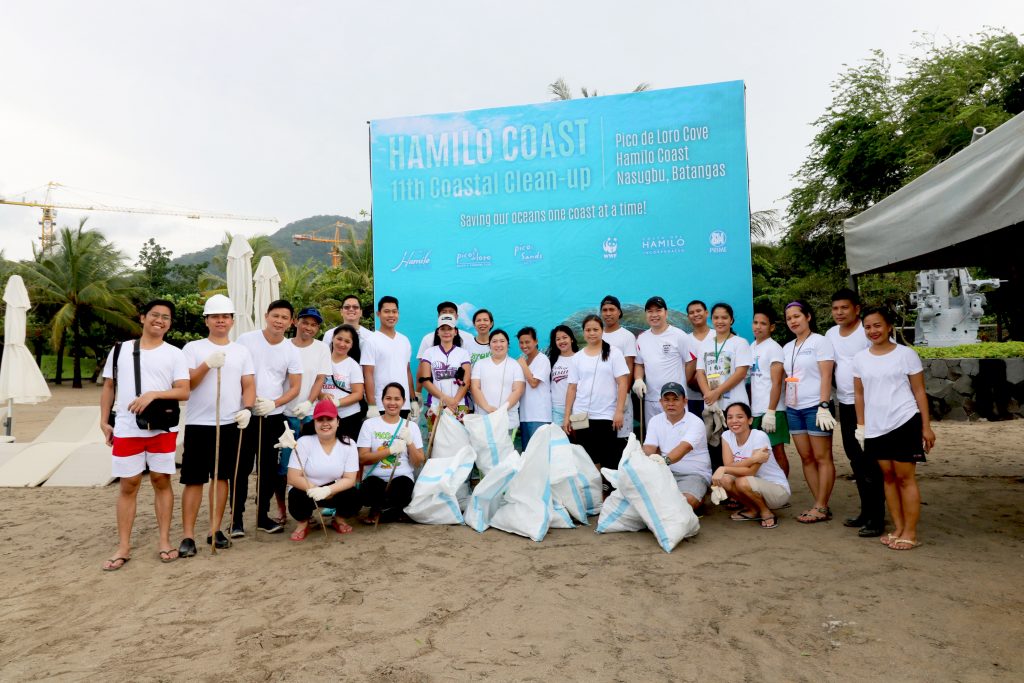Hamilo Coast and WWF advance environmental awareness by celebrating occasions that show respect for biodiversity such as coastal clean-up.
The premier beach resort town on the Hamilo Coast, Nasugbu, Batangas, may be the weekend haven of the country’s affluent set, yet it is on track as a thriving model of sustainable eco-tourism practices.
Considering 5,800 hectares of prime seaside development, Hamillo Coast SM Prime’s Costa del Hamillo, Inc. (CDHI), which carefully integrates residential, resort, leisure, commercial and institutional land uses into a vast property. But beyond its vast scope and stunning vistas, Hamilo Coast embraces sustainable tourism at the core of its philosophy and shows how beautiful beach houses can harmonize with nature and the environment.
The Hamilo Coast embraces sustainable tourism at the core of its philosophy and shows how beautiful beach houses can be in harmony with nature and the environment.
2022 marks the 15th year of a productive partnership with the World Wide Fund for Nature Philippines (WWF), a conservation group off the Hamilo Coast. Hamillo Coast and WWF are working together on key areas of sustainability—coastal resource management, ridge-to-reef management, solid waste management, mangrove afforestation, the use of renewable energy sources, and environmental awareness.
This long-standing collaboration with WWF reflects Hamillo Coast’s determination to advance eco-tourism and sustainability while upholding international standards for leisure property development
Ms. Imi Francisco, Vice President and Head of CDHI Projects and Operations, takes pride in the partnership’s objectives. “More than building and maintaining a beautiful community, we want to create and maintain a world that future generations can enjoy. To help serve this purpose, CDHI does not compromise on the quality of the wildlife that lives around it. Bina Hamillo continues to develop the coast.”
Santelmo Cove was one of those declared as a Marine Protected Area (MPA), which is considered a coastal area where human activities are strictly regulated to ensure their long-term conservation.
This year, Hamillo Coast and WWF will focus on addressing key components on waste management, including assessment of solid waste, water and wastewater management practices, creating an environmental management plan, and promoting food shed farming systems. In addition to these, the Hamilo Coast and WWF will continually work on programs that will help protect, conserve and nurture the environment.
For one, the Hamillo Coast and the WWF’s Ridge to Reef program declared three of the Hamillo Coast’s 13 coves—Pico de Loro, Atayo and Santelmo—marine protected areas (MPAs). These are coastal areas where human activities are strictly regulated to ensure their long-term conservation. Declaring a higher MPA would also mean expanding the scope of the Hamilo Coast in protecting more marine ecosystems and resources.
Hamilo Coast continues to implement a mangrove afforestation program in its 24-hectare mangrove belt—the largest mangrove belt in Nasugbu. Here, Hamilo has put together 50,000 propagules, hand-in-hand with the World Wide Fund for Nature (WWF) Philippines.
Mangroves are the first line of defense for coastal communities, stabilizing the shoreline by preventing erosion and providing a natural barrier to storms, floods and hurricanes. As an effective carbon storage, mangroves absorb six times more carbon than mature tropical forests, making it all the more important in slowing the effects of climate change.
Finally, the Hamilo Coast and WWF will advance environmental awareness by celebrating opportunities that show respect for biodiversity. Earth Hour is an annual event during which people are urged to turn off the electricity to make a substantial difference in energy consumption. On Coral Triangle Day, individuals, organizations and institutions also come together to shed light on the conservation of the ocean and the ways in which we can protect and preserve the world’s center of marine biodiversity.
Similarly, the development boasts the largest volunteer effort for ocean health, made possible with the International Coastal Cleanup, where people gather on Pico and Santelmo beaches to collect trash and record information on the debris collected. Huh.
For all these sustained efforts, WWF has awarded Hamilo Coast the Longest Sustainability Partner Award, in recognition of its development commitment to sustainable tourism and its positive impact on the Philippine tourism industry.
Francisco confirmed, “CDHI is proud of how far we have come on the Hamilo Coast with the help of WWF. It inspires us to do even more, in the hope that our efforts will be passed on to generations to come. We will make it possible for us to see the beauty of nature. We see it today.”


Post a Comment
Any comments, my dear?